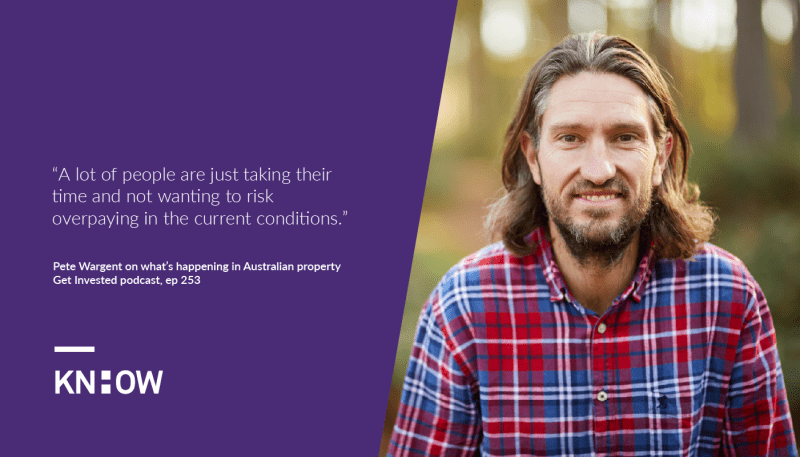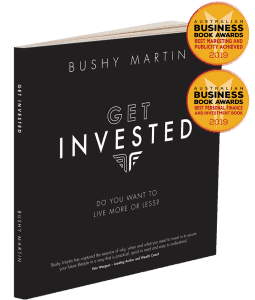Pete Wargent says a slower pace, increase in demand and continued movement to outer city locations are some of the trends investors can expect in 2023.
The six-time published finance author and leading investment analyst is a regular guest on Bushy Martin’s Get Invested podcast. In their latest chat, Pete provided insights into where the Australian property market is heading.
A slower pace for Australian property
Unlike the hype experienced during the peak of COVID, the property market has slowed down in 2022, with buyers expected to show continued caution in 2023.
“If we think back to 2021, things were fairly manic for a while there. But now things are going from nuts to normal, so it has definitely slowed down. I think a lot of people are still getting their mortgage pre-approval, but there’s just less FOMO in the market, less panic decision-making, and a lot more caution,” Pete said.
“So I think a lot of people are just taking their time and not sort of wanting to risk overpaying in the current conditions. You can also negotiate much more forcefully now. So the market is still ticking along, but certainly a lot slower than it was last year.
“Eventually we’ll get towards the peak of the fear and we’ll start to see a bit more optimism. But probably in the new year when people stop worrying so much about rising interest rates.”
Pete believes 2023 will also see first home buyers slowly re-emerge into the market.
“In New South Wales, stamp duty can be scrapped for first time buyers from January, so that will start to get things ticking over again in the new year. And I think a lot of first home buyers who’ve got access to the bank of mum and dad or the ability to save the deposit, I think they will take the opportunity to get into the market,” he said.
A change in supply and demand
Pete forecasted that Australia will experience extremely high demand for property, which may be impacted by the challenges in supply.
“The underlying fundamentals for demand in housing are probably the highest they’ve ever been. If you look at the projected population growth for the next decade, we’ll probably see another three million people in Australia by the end of 2030 … And this to date is largely things like working holidaymakers and international students. But we’ve got all the permanent migration to ramp up again next year and we could see population growth of 500,000 over the next year or so per annum. So there’s big numbers coming, and the amount of demand for housing is going to be phenomenal,” Pete revealed.
“And there are a lot of challenges now in terms of supply, with developers facing insolvency, particularly in south east Queensland. Materials prices are very, very high, and a lot of projects are being scrapped or mothballed. We’ve had flooding in various parts of the country, so the housing construction is slowing down now. And if you actually look ahead, building approvals are falling and new home sales are falling. The rental market is also already at record lows for vacancies and there’s no end in sight there.
“So I think that’s really what’s going to characterise the housing market over the coming years. There’s going to be a record level of demand and only so much supply there can be delivered, particularly in those sort of key landlocked middle range suburbs or regional centres where people want to live.”
Although on the other hand, rising interest rates may work to ease some of this demand.
“With interest rates going from 0 to 3%, that does have an impact on the ability of some households to borrow. Now of course not every household borrows the absolute maximum for their purchase, but it does make a difference with the margin. So reduced borrowing capacities and increasing interest rates have reduced some of the demand in the market,” Pete said.
Continued movement to outer city locations
Middle range suburbs and regional locations continue to provide opportunities for property investors and home buyers.
“It depends on your budget. There’s good opportunities in Sydney and Brisbane, and I think in some of the regional centres as well. If you’ve got a slightly lower price point, there’s plenty of those what I call peri-urban locations. So they’re not capital cities, but within that sort of two hour gravitational pull of the capital cities,” Pete said.
“There’s a lot of demand shifted outwards with the working from home phenomenon. So Hunter Valley, Central Coast, those are some of the types of areas that have been popular. Ditto, the south coast of New South Wales, we’re certainly seeing it in regional Queensland from Gold Coast to Sunshine Coast. The same applies in parts of Victoria as well.
So it really depends on your budget and what you’re trying to achieve. But for a lot of it, the principles of good property investing haven’t really changed. High land to asset value, something you can rent out for a good rental return, possibly some future value add potential. Those are the kinds of things you tend to look for and you generally get really good results from over time.”
A push to focus on the bigger picture
Maximising your growth in the property market will always come from looking at the big picture and your long-term goals, rather then quickly reacting to the latest media commentary.
“Property tends to work best as a 10 or 20 year investment, or possibly even longer if you buy really well. But the nature of the beast these days, particularly with online media and clickbait headlines, is that everybody’s focussed on what’s happening this weekend and next week … if you see a headline in the newspaper saying that house prices are going to rise by 20% or fall by 20%, it does suddenly capture your attention,” Pete said.
“When the market is absolutely booming, people feel an unholy need to get into the market as soon as possible. And then the reverse is true. When prices are falling and the media headlines are talking about gloom, then people think, oh maybe I should be selling, when that’s the exact opposite of what you should be doing. But those property market cycles, as much as anything else, they’re driven by fear and greed, and I think that’s the same in all financial markets.”
Listen to the full interview here.
Want to Know How you can build wealth with the help of leading, qualified experts? Check us out and talk to the team, now.




